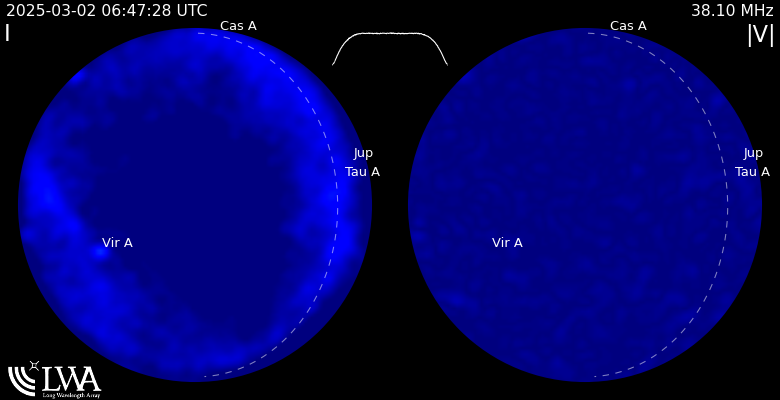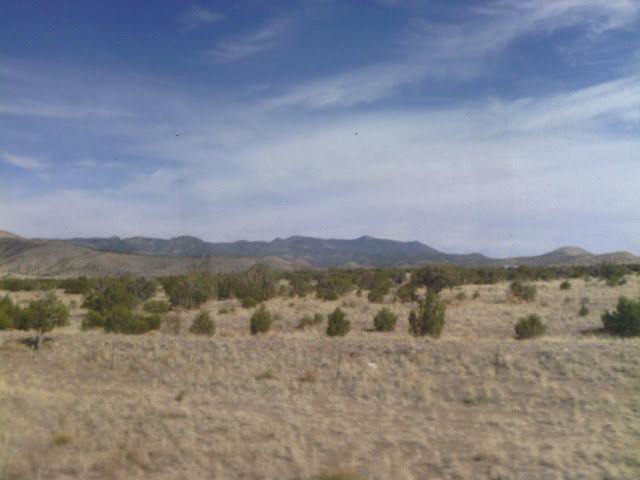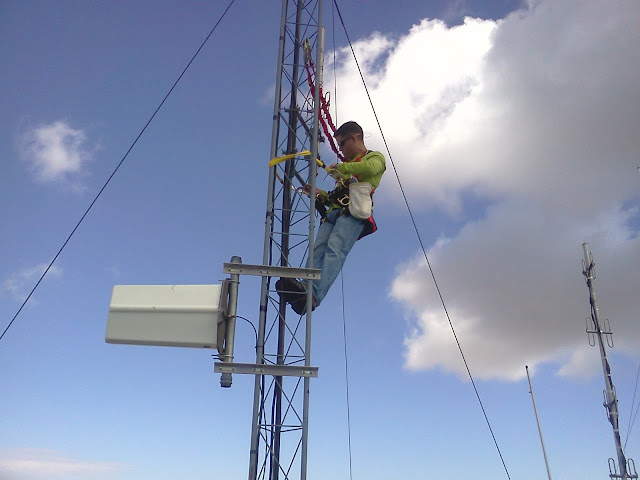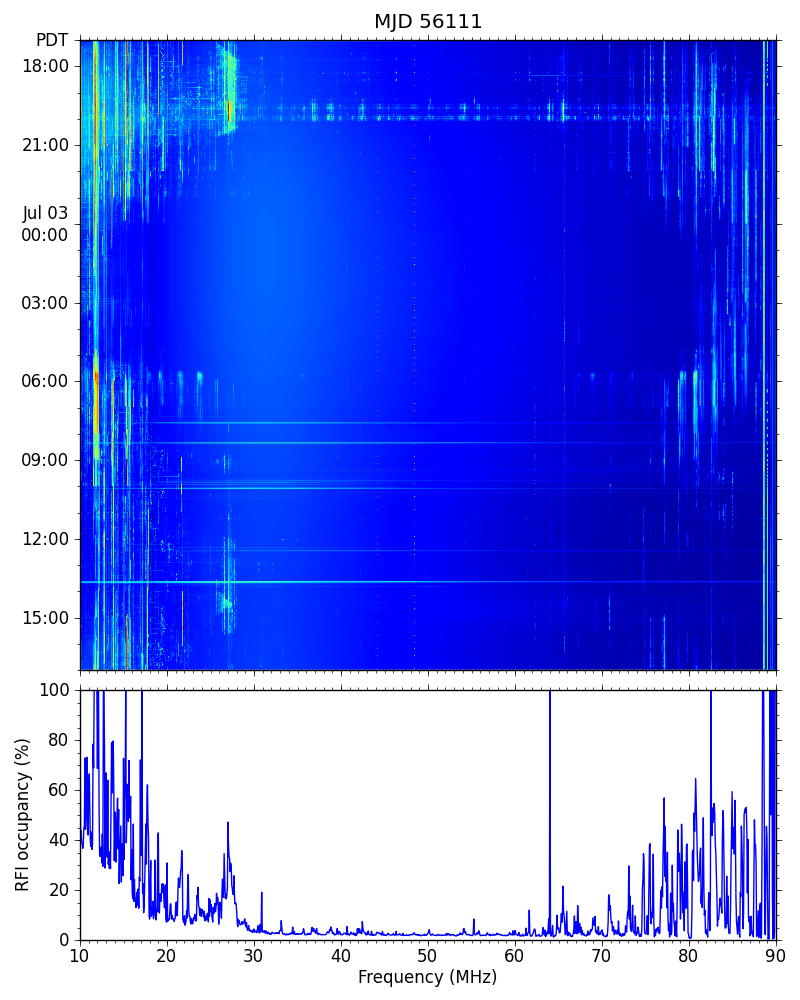Posts Tagged ‘socorro’
 Repeater work on Sandia Crest
Repeater work on Sandia Crest
I had the opportunity of a lifetime to traverse through the nation’s most RF dense mountaintop towersite, and possibly reduce my chances of having children by a large amount…in any case, today’s work was bucket loads of fun.
| Towers lining the crest. [Wikimedia user Skoch3, Photo] |
The work at the site was simple — some regular maintenance to the W5MPZ D-STAR repeater and gateway.
So, I got up early and headed off to Ed’s (KA8JMW) place to pick up the caravan to the peak. We packed the truck with some server rack shelves and tools, and headed to pick up Brian (N5ZGT), then Chris (NB5T).
And then, the 10,768 ft (3,255m) summit.
The road was blocked by the Forest Service since the park was closed due to fire danger. Thanks to some prior planning, we had no trouble getting past.
And not two turns in to the curvy mountain road, we meet our first deer, head on. Thanks to Ed’s quick foot on the break (maybe he was practicing for QLF?) the deer zipped across the road, perhaps only with a bruised tail.
We were warned that with the lack of humans, nature tends to take over a bit
The one thing I though of going up the road is, what if you had this road all to yourself (like we did then) with a nice, fast rally car?
I think deer would have a problem with that.
Anyway, we got to the top, and met the first obstacle:
Chris dispatched the lock on the well-signed gate and we were in. At that point, we had entered the danger zone; the steel forest. With at least 26 FM stations, almost half being over 20 kilowatts, 33 TV stations, more than half over 100 kW, and an uncountable number of microwave dishes, log periodics, yagis, verticals, radomes, funny looking phased arrays and dipoles supported on dozens of massive towers, I swear I could hear KOB in my teeth.
After driving through the entire site, we arrived at our final destination: the Sandia Nat’l Lab’s personal radio playhouse.
The guys began working on equipment, while I snapped photos and gazed in awe of the city of Albuquerque all within my field of view.
 |
| Chris, Ed, and Brian “working.” |
Brian took the job of tightening the D-STAR antenna, which he did adamantly, without falling, thanks to his fancy harness. It’s funny how dinky that antenna seems, but being over 3,000 ft ( 914m) above the rest of the world, it can see almost 100 radio miles (150km). With my 40w mobile radio, it comes in full signal in Socorro, NM, 75 miles (50km) away.
The team was successful of getting things done, cleaning up the shelves of an obtrusive monitor, keyboard and mouse (by going SSH only) and installing a NetIO internet-controlled AC power killswitch.
 |
| Before… |
 |
| After. Notice the new black box on the top right. That controls power for the whole thing via the web. |
The work was complete right on the dong of noon, and we had ribs for lunch. YUM! After that, Chris’s wife treated us to some homemade ice cream at his place, and we toured his shack, nestled on the edge of a HOA-restricted subdivision. That doesn’t stop him from loving ham radio!
Next on the list is to move this stuff to its permanent home on server racks. Sadly, I won’t be here, with only two weeks left in my VLA internship. I don’t wanna leave! 🙁
I would like to thank Ed James KA8JMW, Chris Aas NB5T and last but not least, Brian Mileshosky N5ZGT for taking me on this mighty heighty outing. Perfect timing for knocking another thing off my New Mexico to-do list.
The only part I forgot on that list was to bring a spectrum analyzer up there. It would have probably blown up in my hands.
 |
| Me, Ed, Chris and Brian on the edge of the crest. |
 Upcoming SOTA Activation of W5N/BA-005 on 20 July
Upcoming SOTA Activation of W5N/BA-005 on 20 July
If you’re coming from sotawatch.org, welcome!
—Details—
Peak: W5N/BA-005 – 7284 [Socorro Peak]
Location: Socorro, NM, DM64mb
Time: 20 July 2013, 1700 UTC
Bands: anything I can manage. Likely 20m and up, and 2m
Mode: SSB preferred, but I want to try to muddle through some CW. I’ve never done CW without a computer (shame on me) so PSE QRS!
On 20 July, I plan to activate a nearby mountain for SOTA. This isn’t any regular mountain – the some parts of the road up to the peak is owned by EMRTC, or, simply speaking, its a bombing range. Therefore access is permit-only and this plan is tentative at the moment [edit — It’s a go!!]. However, at last night’s Socorro ham club meeting, I met a guy willing to be my escort, so I don’t get blown up, and to make sure I don’t steal anything, I suppose.
| Map of the area and the Summit. [http://sotamaps.wsstvc.org/] |
BA-005 is known as 7284 on the SOTA map, but the peak is commonly referred to as M-Mountain or Socorro Peak. A nearby peak which has a large, limestone M on it isn’t included in the database because it’s too near the taller peak.They only differ in elevation by about 60 feet.
This shorter peak is the home of the famous Elfego Baca Golf Shoot, where participants tee off at about 1500ft above and 2 miles awaythe hole. I think it’s a par 36 😀
Instead of golf, we’re going to shoot for some QSOs.
I’ll be using my new fangled End Fed Half Wave coupler and some conveniently placed towers. If those don’t work, then I’ll revert to some hamsticks. Stay tuned for more on the antenna project, and the summaryof the activation!
 If You Had Radio Eyes…
If You Had Radio Eyes…
It’s always been a dream of mine to put on glasses that allow you to see only waves of RF emitting, reflecting and illuminating the world around you…this would make my job so much easier too!
Well, there just so happens to be such a thing that allows you to see RF…it only requries about 3 acres and 250 antenna elements, a supercomputer and a fast internet connection.
 |
| The LWA near the VLA |
The Long Wavelength Array is a seemingly random assortment of crossed dipole pairs with a frequency response of 10-88 MHz. Every antenna is separetly fed into a giant computer that correlates and beamforms the array into a giant RF eye looking at the sky.
 |
| LWA Dipole Detail with the VLA in the background |
And by eye I really mean it sees the RF world above it in real time:
 |
Above is a real time view of the sky above the LWA (hit F5 to refresh, I dare ya!). During the day you can see the sun and several radio sources like Cas A, Tau A, and Cyg A which are galaxies, pulsars, and other nebulae of ridiculously “loud” RF emitters. Also, at the top and top left, you can see RFI from the VLA site, which is one of the things we’re working to alleviate.
Another cool thing it can do is plot spectrum over the whole day:
This shows the intensity at all frequencies between 10 and 90 MHz over a 24 hour period starting at 17:00 PST 11 July 2012. You can watch the nighttime MUF drop between 00:00 and 06:00 PST, and surge again at sunrise. Other strange and interesting patterns exist as well — check out the index at http://lwalab.phys.unm.edu/lwatv/ovro and see what you can find.
Ckeck out their website at www.phys.unm.edu/~lwa/lwatv.html and read technical information about the LWA here, and an even more technical dissertation here.
73!
 Fire, Lightning, Wind and Dust: New Mexico Weather
Fire, Lightning, Wind and Dust: New Mexico Weather
New Mexico is dry. I was floored when it rained three days ago. But for 11 months out of the year, the air is dry, the sun is bright, the clouds are facetious, and everything’s on fire.
| Smoke plume from the 30,000 acre Silver fire |
| Smoke fills the horizon |
Such is life in NM. The 10% humidity caused me some pain and suffering for a while, but I seemed to got used to it. I used a lot of normal lotion, which wasn’t the best idea for being out in the sun so much.
Currently, a large chunk of the Gila mountain range is on fire, but thankfully few people live in the area. The Silver fire (named because its near Silver City, NM) is currently at 32,000 acres, making it the biggest fire in the US. From atop a VLA dish, you can see the smoke plume and the long trail of smoke being carried by 30-40 mph surface winds. It’s quite dark in Truth or Consequences.
Aside from the fire, the plains of central New Mexico have a variety of weather, typically involving some kind of dust and lots of wind:
 |
| Dust carried aloft by 40 mph winds |
We even have tornadoes of dust! (Seriously, some of them are big enough to cause damage):
 |
| A particularly strong dust devil with a well defined center column |
Then, all of a sudden, it storms:
 |
| A snowstorm to the north…it’s a rare event to see precip actually get to the ground. |
Above, you see it’s snowing. Snowstorms in the southwest isn’t a myth after all! Just last year, a snowstorm dumped 2′ of snow on Socorro, NM.
Typically though, the air is so dry that any precipitation just evaporates before it hits the ground. This phenomena is called virga, and is the sole reason why the clouds are so facetious. What does hit the ground are tendrils of lightning, graupel — basically mini snowballs from the sky — and hail.
| A tendril of lightning betwixt two VLA dishes |
In 2004, hail fell with a vengeance:
So its dry, its dusty, windy and usually boring (minus the bits of hail, getting caught in a haboob, and waking up to lightning barrages)…but now is the season for rain. And we’re in dire need. NM has been in a 10 year drout, and wells are drying up like int he community of Magdalena, NM, just east of the VLA.
Locals believe that July 4 is the day which marks the start of the monsoon season…don’t take monsoon to seriously though, it’s not like the monsoons of India and Asia. They may dump 2″ of rain, but that gets sucked up so quickly by the dry, absorbent dust and flora of the mountain ranges that it was like it never happened the next day.
We’ll see what the skies bring.
 (A)Typical LBR installation
(A)Typical LBR installation
Like I mentioned, today Paul Harden, da boss, and I installed two more low-band receivers today, but with only a 50% success rate.
The receiver is dual banded for 74MHz/350MHz and is housed in a big and heavy 8″x12″ metal box. for thermal stability. We call them LBRs or 4/P receivers — 4 band is 58-80MHz (eg 4 meter wavelength) and P-band is 325-420 MHz or so. P comes from it’s old military designation, like L, S, C, X, Ka, K, Ku, radar bands, etc.
She’s mounted on a sturdy mount inside the “barrel” also known as the Focus Rotation Module, or simply the apex. It’s also my second home. Inside the barrel is a central square steel through which the 4-band antenna and receiver output cables go through. The receiver mounts near the bottom of the apex, and plugs in to 8 different cables – two pairs of Heliax for the 4/p band crossed dipoles, one Heliax pair for the output, a power cable, and a calibration signal cable.
Each antenna input requires two pair because of the dipole design — they’re orthogonal crossed dipoles that are fed into the receiver as two linear polarizations. Some magic happens in the LO-IF rack that either sends them as a linear polarization to the correlator (mainly for ionospheric observations) or combines them in quadrature to provide left- and right-circular polarization for observations outside our own solar system.
The first installation went smoothly — we removed a malfunctioning receiver from antenna 18 and replaced it with a fresh one — it’s pretty much plug and play. Somewhere through, we lost a two-way radio. No idea where it went. I think it always existed in some kind of quantum state, and now it’s hiding.
The second was troublesome. Each output, left and right polarization (or X and Y) should show clearly the band passes of each band through a spectrum analyzer. What we saw was spikes caused by the 74MHz *something* oscillating like a runaway Hartley. (that was a pretty poor play on words)
So we hit it a few times, jiggled the cables, and poof, it was back to normal! We came back down to the vertex room to find it again went nuts. So we went back up, wiggled some more, and took the SA with us. Now the X side was gone! We took the cover off and poked around, but it was dead. Methinks the oscillation was strong enough to saturate an LNA, bust a cap or diode or two, and kill X.
Paul’s gonna play with it tomorrow, and we’ll see if we can make our pseudo-deadline of getting everything working by Tuesday night. Lots of pressure from the higher ups.
Tonight, I’mma gon’ write a blurb about the SDR demonstration at the ARRL Youth Lounge at Dayton for Ward Silver, N0AX, upvote and argue things on reddit, and buy some wire and ladder line for field day. Need to make a 9:1 balun by then too.
 |
| View of South baldy and the Magdalena Ridge from the bus ride home |
 What I’m up to at the VLA
What I’m up to at the VLA
Back last November I was offered this internship to work for up to 8 months at the Very Large Array, as you see pictured behind this post. The VLA is the worlds most prolific radio observatory, having the most citations in of any radio observatory in all of science. I could not turn this offer down/
The VLA is a well oiled machine of 27 cassegrain feed parabolic reflectors each 25 meters, or 82 feet wide, that send concentrated RF to massive feedhorns at its vertex. One VLA dish covers all frequencies from 1-50 GHz, and has two extra bands at 74 and 350 MHz using extra antennas. Together, they can make a dish that theoretically measures over 20 miles in diameter!
 |
| Apex of a Dish Showing the Cassegrain Subreflector, 350MHz cross-dipole at the center of it, and the new strut-straddling sleeve-dipoles for 74MHz around the edges being installed |
My primary job at the VLA is to learn. Everything RF exists here, so I’m soaking up as much as I can. I’ve learned more about microwave RF design, Radar, synthetic aperture synthesis, correlation, radio astronomy, antenna design, transmission lines, test equipment, RFI, and much more that I have ever (and perhaps will have ever) at college.
Learning is a sort of meta-job. What I really do is two-fold.
The first fold is Interference Protection. The IPG specializes in the detection, location, analysis, and mitigation of radio frequency interference that has the potential of ruining and/or corrupting observations of the radio sky. The VLA is located in a lake bed, 20 miles away from any town, 90 miles from Albuquerque, surrounded by 360° of mountains that buffer the observatory from radar, wifi, cellular, aircraft, and other terrestrial sources of RFI. Satellites are also a source of RFI, so they must be documented and their transmissions well understood so that the VLA Correlator can learn how to discern orbiting transmitters from galactic transmitters.
On IPG, we’ve done a few RFI Site Surveys at places like the Magdalena Research Observatory on South Baldy and at the Pie Town VLBA site. Unfortunately, a Verizon 4G LTE cell tower exists on a hill only 5 miles from the center of the array. The signal it produces isn’t bad — it’s the amount of visitors who show up with a full signal, assuming it’s okay to use their smartphones to upload photos, videos, sprout WiFi APs, and cause all kinds of problems. That’s when we break out the CELL PHONE DESTROYER 6000.
For quieter RFI, like satellites and terrestrial transmitters, we use a big-ugly 10-foot dish with a wideband conical-log spiral feedhorn to determine bearings to RFI:
Along with intentional radiators, unintentional transmitters like microprocessors, screens, TVs, and other electronics produce noise that can be detrimental to the RF environment. Such electronics need to be tested in the Reverberation Chamber, and shielded if necessary.
The second fold is Front End — Front end of receivers that is. On the FE group, I’ve been tasked of removing old low-band receivers (74 and 350MHz) and installing new consolidated ones along with about 200 feet of heliax and control cables for them. I’ve also been building and improving antenna designs for the LBRs, including the new strut straddling dipoles pictured above. I’ve come across a cool 74MHz widebanded antenna design that may or may not be patentable, so we’ll see from it’s creator if I can get acknowledged in a paper or something 🙂
The LBRs are located in the apex, also pictured above. It’s fun becoming a grease monkey while getting a view of the VLA few have seen.
| Such a view |
So how did I get this job? Ham radio of course! My boss actually e-mailed me after an unsuccessful run through career fairs and internship searches for this summer. He noted my experience with the Missouri S&T ARC, W0EEE, as a big kicker on my resume. At S&T I’ve done a lot of work mitigating RFI, fixing repeaters, learning about radio, and having fun with it. He himself is a ham, albeit inactive, but still understands the value a license can have at such a job.
Ham radio gets jobs! (Girls? No.)
Today Paul Harden (NA5N) and I will be installing a few new LBRs in antennas 18 and 20. The weather looks beautiful for it too! Check out Paul’s personal website, chock full of receiver data, photos, and the history of the area.
That’s about the gist of it. 73 for now!
 A Zero in Five Land – Welcome
A Zero in Five Land – Welcome
With midnight inspiration comes morning desperation. For sleep. Heh heh.
Welcome to the new blog of N0SSC — ARRL Youth Editor, EE degree seeker, Very Large Array intern, and among other things, a radio amateur. Ideas have been flowing from my mind into thin air, so I have done up this blog to start to capture them.
I’m a zero in five land. My call sign – N0SSC, shows that I am from zero-land: the ham radio call district that makes up most of the midwest. Due to my internship, i’ve been displaced to New Mexico, which is in the fifth call district – 5 land.
So, this blog will focus on my ham radio activities while in New Mexico, as well as my internship at the Very Large Array. I have a lot of fun stories to share!
Stay tuned for more! For now, follow me on your favorite social networking site — just google N0SSC and you’ll find me.























